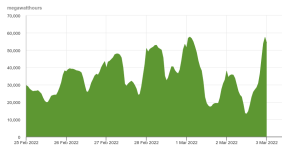The author, who had some expertise in systems that include solar+storage (S+S), used actual costs for the Vogtle [nuclear[ reactors that are being built in Georgia. The two reactors, which have been under construction since 2013, are expected to come online in 2022 and 2023, at a cost of roughly $30 billion, including $3 billion in finance costs. Their capacities will be 1,117 megawatts each.
The PV Magazine article calculates the cost of a solar array big enough to provide the same output as the nuclear reactors in the winter in Georgia. It assumes battery storage to supply the output of the nuclear plants for 16 hours, increased by 10% to be safe.
The author shows that the cost of the S+S system designed to replace the two new Vogtle reactors would cost a little less than $17 billion. That would represent a saving of about $10 billion, not counting finance costs.
While that sounds impressive, the article fails in a number of respects. Here are some:
Output of the S+S system is calculated to be the same as nuclear in the dead of winter. The nuclear plant’s output will be constant year round, but the S+S system will produce far more electricity nearly all year than in the dead of winter. The value of the extra electricity from S+S is not accounted for.
The cost of the nuclear plant does not include the backup systems it requires, but the price calculated for S+S does.
The load-following and peaker plants used to work with nuclear power, are slow to react to demand changes. By comparison, battery backup can respond nearly instantly, making it far more valuable.
Nuclear waste is an unsolved problem that the U.S. government guarantees, at taxpayer expense. The same is true for insurance, which is covered by the Price-Anderson act. S+S systems do not have comparable costs.
The author does not take into account Wright’s Law, a recognized law of economics referred to as “the learning curve.” It suggests that construction of a battery system of the size envisioned would be sufficient to drive the cost of storage down quickly enough to reduce the cost of the S+S system itself.




